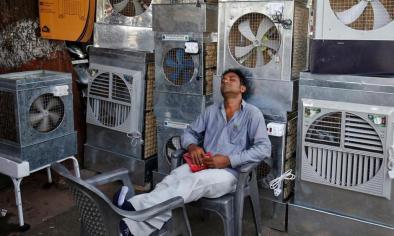Heat wave in India: Climate change is here, prepare for irregular weather, says senior meteorologist

Temperatures across the country have reached soaring highs. A village called Bhira from Raigad district in Maharashtra recorded the worlds second highest temperature of 46.5°C on Tuesday. This was considered abnormal as Bhira lies in the coastal region. What are the reasons for this? Firstpost spoke to Jeevanprakash Kulkarni, a senior meteorologist from the Indian Institute of Tropical Meteorology, who is presently associated with a forum called Satarkindia that issues warning based on various climatic scenarios.
Edited excerpts follow:
Bhira recorded the highest temperature of 46.5°C that proved to be second highest in the world on that day. Has a similar phenomenon been observed previously?
Bhira lies in the coastal region. So the possibility of temperatures reaching such highs is low. But the hot winds blowing from the North and East combined with the winds on surface-level. This led to the rise in temperature. This phenomenon can occur in various places. On Tuesday, we saw a rise in temperature in Bhira and on Wednesday, a record high was observed in Bhandardara.
So what are the reasons for this? Is it a localised phenomenon?
We are witnessing a heat wave across the country. When the temperature rises 3°C to 4°C above normal it is termed as a 'heat wave'. We can see that the average temperatures have gone up. The reason is that the hot winds are blowing from deserts and these are combining with the dry winds on surface. An anticyclone that was formed in Central India has now covered the entire country. Simultaneously there is no cloud formation. All these situations are causing the heat wave.
We normally witness a rise in temperatures in the month of April. But this year it has happened at the end of March. Why is that?
The reason is the anticyclone. Normally, anticyclones are formed in Gujarat and Rajasthan in the month of April. This year, it happened earlier. It has also occupied the entire country now. Hence, the heat wave and the rise in temperature can be seen. Normally, when the temperature rises in the month of April, there is thunderstorm activity to balance it.
So, it's normal for the anticyclone to form in the month of March?
No. It is expected to form in April. I think this is the result of climate change. We saw untimely rainfall this year. Now we are witnessing a heat wave. The cycle is changing. If we go through the average temperature data, this sort of temperature rise has never been seen. It is the percolation of climate change. These are the local effects of climate change that are now visible. If we consider Maharashtra, the maximum temperature that has been recorded is 43°C and that too in the region of Vidarbha. Pune has rarely crossed 40°C. But it is different this year.
Is this an alert?
We normally speak of climate change. But this situation tells us that it has reached our doorsteps now. But this is an indication that we need to initiate action. Steps are being taken all over the world. But our proactive role in fighting climate change will be needed now. It is going to be important.
How long do you expect this situation to continue?
This situation might continue till 3 April. Temperatures might subside after that. Cold winds are expected to flow from the polar region. So the temperature might decrease. On an average, the temperature might dip by 3°C to 4°C.
Can this possibly have an adverse effect in the coming days?
There are chances that a similar anticyclone might be formed during the onset of the monsoon. It will affect the Northward progression of the monsoon. The progression will be irregular and will have an impact on the rainfall. This is a reason to worry.
Related Content






